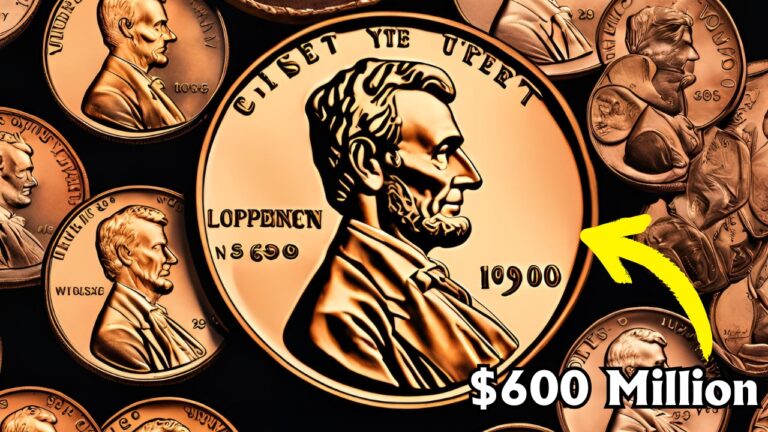
The Lincoln Wheat Penny isn’t just any old coin you might find buried in a jar of forgotten change. For decades, collectors and history buffs alike have been charmed by its rich backstory, iconic design, and the occasional eye-popping auction prices. Could one of these little copper coins truly be worth millions? Let’s explore the intriguing world of the Lincoln Wheat Penny and see what makes them so special.
The Beginnings of a Timeless Coin
First minted in 1909 to celebrate the 100th anniversary of President Abraham Lincoln’s birth, the Wheat Penny quickly became a staple in American cash. The coin’s design, crafted by Victor David Brenner, featured a profile of Lincoln on the front and two elegant stalks of wheat on the back, giving it the nickname “Wheat Penny.” This straightforward yet memorable design stayed in circulation until 1958, when the coin received a design update.
Though billions of these pennies were made during their run, not all of them are created equal. Some hold immense value due to their rarity, unique errors, or fascinating history.
Can a Penny Really Be Worth Millions?
If you’re imagining stumbling across a $600 million Lincoln Wheat Penny, I’m here to tell you to hold your horses. That claim? Definitely a stretch. But don’t worry—Wheat Pennies can still be valuable and hold tremendous allure for collectors. Here’s a breakdown of what these coins are typically worth:
1. Everyday Finds: Most Wheat Pennies from common years like the 1940s and 1950s are only worth a few cents more than their face value if they’ve been in circulation. Think five or ten cents tops.
2. Rarer Dates: Coins with lower mintages or unique characteristics, such as a 1914-D or 1931-S, may fetch anywhere from $20 to $200 depending on their condition and demand.
3. High Rollers: Big player Wheat Pennies, like the highly collectible 1909-S VDB, can sell for several thousand dollars. These are the coins collectors dream about, with some prices running up to $10,000 in pristine condition.
4. Error Coins: The real stars of the Wheat Penny world are mistake coins. For example, the 1943 copper penny—a blunder created during war-time production—has been known to sell for over $200,000. Similarly, the rare 1955 Double Die Obverse coin, with its striking misprint, is a valuable find worth $1,000 or more.
A Closer Look at the Legends of Wheat Pennies
Certain pennies have become bonafide legends in the numismatic world. Here are just a few that collectors go crazy for:
- 1909-S VDB: The first year of production and with a short-lived design detail—this coin features the designer’s initials, VDB, on the back, causing controversy at the time.
- 1943 Copper Penny: A fascinating mint error when pennies were supposed to be made of steel for war purposes. These copper versions are beyond rare.
- 1955 Double Die Obverse: A unique misprint that creates a doubling effect on the date and letters.
Each of these coins isn’t just a collectible—they’re a slice of history.
What Makes Some Pennies Valuable?
Not all Wheat Pennies are destined for fame and fortune, but a few key factors can help boost their value:
- Rarity: Fewer coins from specific years or mint locations result in higher demand.
- Condition: A flawless or near-flawless coin commands much higher prices than one that’s been beaten up in a pocket.
- Historical Importance: If a coin tells an interesting story or marks an important event, collectors are quick to take notice.
- Mint Errors: Collectors love a good oddity, be it a botched imprint or material error.
Collecting as a Passion and Investment
Is Wheat Penny collecting just a hobby? Absolutely not. For many, it becomes an investment opportunity. But before you start digging through your old coin collection expecting a goldmine, here are some tips to keep in mind:
- Do Your Homework: Understand the rarity and condition grading that affect coin values.
- Condition is King: Always aim to collect coins in the best condition you can find or afford.
- Verify Authenticity: When it comes to high-value purchases, trust only certified dealers and have coins authenticated by professional graders.
- Diversify: Don’t put all your money into just one coin. Spread the risk by building a varied coin collection.
Why We Love the Lincoln Wheat Penny
The real magic of the Wheat Penny is what it represents—an enduring connection to America’s past. These coins were witnesses to two World Wars, the Great Depression, and decades of change. For seasoned numismatists and newcomers alike, the Wheat Penny isn’t just about its monetary value but the stories it carries.
What Lies Ahead?
Will the Lincoln Wheat Penny explode in value in the future? Probably not to the tune of $600 million. But as the years go on and these coins grow scarcer, their demand is sure to climb steadily. For now, their appeal rests in their accessibility, historical charm, and the joy of discovering a hidden gem.
If you’ve got a curious eye for history and a love for collecting, the Lincoln Wheat Penny just might be the gold—or copper—mine you’re looking for. Who knows, maybe one day you’ll be the lucky one to stumble upon a prized piece of this numismatic treasure. Keep your change jars close, and happy hunting!